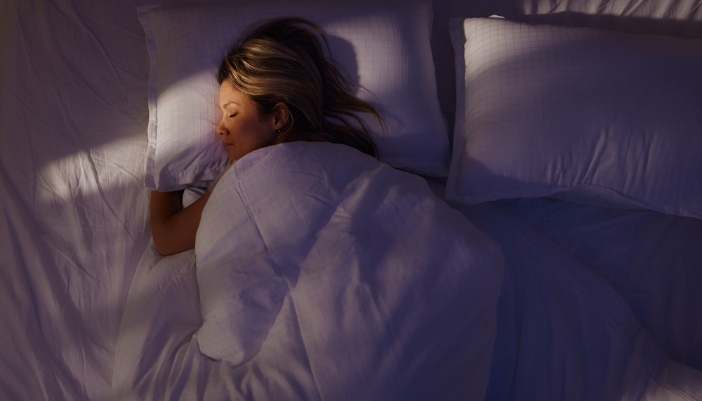Waking up in the middle of the night because of a noise or nightmare can be stressful, especially when falling back asleep seems nearly impossible. Often, we end up staring at the ceiling, wishing we could drift off again and start our day more tired than ever.
But you don’t have to be stuck in no-sleep-purgatory; at Hudson Appliance, we have some practical tips you can explore to reclaim those precious hours of sleep and help you wake up refreshed and ready to tackle the day — every minute of good sleep counts!
1. Calming the Mind

Finding yourself awake at night can be unsettling, but controlled breathing and meditation offer a peaceful path back to sleep. These techniques help quiet the mind and relax the body, making it easier to slip back into restfulness.
- 4-7-8 Breathing Technique: This simple exercise involves inhaling through your nose for 4 seconds, holding the breath for 7 seconds, and exhaling through the mouth for 8 seconds. Repeat this cycle four times to help reduce anxiety and induce sleepiness.
- Mindfulness Meditation: Focus on your breath and observe your body's sensations without judgment. If your mind wanders, gently bring your attention to your breathing to enhance relaxation.
- Body Scan Meditation: Start at your toes and move slowly up to your head, noticing any tension and consciously relaxing each part of your body. This can be particularly soothing and conducive to falling back asleep.
- Guided Visualization: Imagine a calm, peaceful place and explore it in your mind. Engaging your imagination can divert your thoughts from stress and lead to a quicker return to sleep.
2. Ignoring the Clock

Glancing at the clock during a nighttime awakening can unintentionally escalate stress, making the quest to fall back asleep even more elusive. It turns out that watching the clock raises anxiety about not sleeping, so instead, try these techniques:
- Break the Habit: Turn your clock away from view or place it in a drawer. If you use your phone as your clock, try putting it out of easy reach.
- Use a Soft Alarm: If you need reassurance about waking up on time, set a gentle alarm. Knowing you have a backup can ease worries about oversleeping.
- Focus on Relaxation: Instead of checking the time, focus on deep breathing or meditation to cultivate a calm mind, making it easier to drift back to sleep.
3. Gentle Illumination

Sometimes, you might need to get out of bed after waking up at night. When this happens, managing your exposure to light is crucial, as too much brightness can signal your brain that it’s time to wake up, not wind down.
- Soft Lighting Options: Use nightlights or lamps with warm, dim bulbs. These provide enough light to move around safely without fully awakening your senses.
- Strategic Placement: Position your lighting so that it's easy to access but not directly shining in your eyes like with a small bedside lamp or motion-activated floor lights!
- Red or Amber Lights: Consider bulbs that emit red or amber light, which have minimal impact on melatonin production, helping to preserve your body's sleep state.
- Limit Screen Exposure: If you use your phone or other electronic devices at night, enable settings that minimize blue light exposure, or better yet, try to keep devices out of reach until morning.
4. Gentle Activities for Sleepless Nights

We know that when you're wide awake in the middle of the night, staring at the ceiling can heighten frustration and make sleep seem even more elusive. That’s why engaging in a quiet, non-stimulating activity is essential to coax your mind into sleep mode — it helps reduce anxiety and lower your heart rate! So, the next time you find yourself counting sheep, try these activities instead:
- Reading a Book: Opt for something light or non-fiction that won’t overstimulate your mind. Reading can tire your eyes and help your brain shift gears toward sleep.
- Listening to Calm Podcasts or Audiobooks: Select soothing content, perhaps with a soft-spoken narrator. Use a sleep timer so you don’t have to turn it off manually.
- Mindful Coloring: This gentle activity is meditative and keeps your hands busy, and your mind focused on the moment, away from worries or anxiety that may keep you awake.
- Journaling: Putting your thoughts on paper can be a cathartic experience, helping you manage any racing thoughts or anxieties from the day. This can clear your mind and prepare it for sleep.
5. Optimizing Your Comfort Zone

If you wake up at night, discomfort could be a key culprit — it might even be the main reason you’re tossing and turning! So, it’s best to consider following these steps:
- Pillow Positioning: Ensure your pillow supports your neck and head comfortably. Adjust or switch out pillows if you frequently wake up with neck pain or discomfort.
- Adjust Blankets and Bedding: Sometimes, the solution is as simple as adjusting your blankets. Make sure you’re not too hot or too cold and your bedding isn’t restricting movement.
- Consider a Mattress Topper: If a new mattress isn’t an option right now, a mattress topper can be an effective alternative. Choose one that adds comfort and enhances the support of your existing mattress.
- Invest in a Mattress Upgrade: A quality mattress with better motion isolation, supportive comfort for your sleep position, and ideal firmness can help you stay asleep longer. And if you wake up, it’ll help you feel more rested even if you don’t get a whole night’s rest.
Your sleep comfort should always be your number one priority. And if your mattress has seen better days or your pillows don’t look like pillows any longer, it’s definitely time to upgrade at Hudson Appliance. We carry all the top brands in the comfort level you need to drift off to sleep faster and stay snoozing longer!
Need help finding what you need? Our experts are happy to lend a hand — give us a call or pop by today!